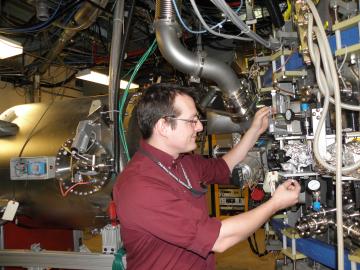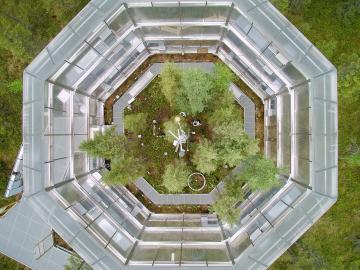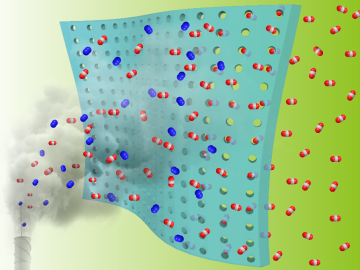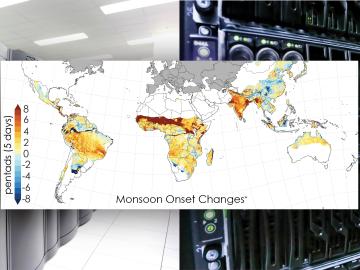
Filter News
Area of Research
- Advanced Manufacturing (2)
- Biology and Environment (79)
- Biology and Soft Matter (1)
- Computer Science (1)
- Energy Science (57)
- Fuel Cycle Science and Technology (1)
- Fusion and Fission (31)
- Fusion Energy (5)
- Isotope Development and Production (1)
- Isotopes (24)
- Materials (42)
- Materials for Computing (4)
- National Security (25)
- Neutron Science (12)
- Nuclear Science and Technology (25)
- Quantum information Science (1)
- Supercomputing (32)
News Type
News Topics
- (-) Advanced Reactors (25)
- (-) Clean Water (19)
- (-) Composites (24)
- (-) Cybersecurity (31)
- (-) Environment (162)
- (-) Isotopes (55)
- (-) Nuclear Energy (99)
- (-) Space Exploration (16)
- 3-D Printing/Advanced Manufacturing (108)
- Artificial Intelligence (114)
- Big Data (58)
- Bioenergy (95)
- Biology (108)
- Biomedical (61)
- Biotechnology (36)
- Buildings (50)
- Chemical Sciences (72)
- Computer Science (180)
- Coronavirus (37)
- Critical Materials (17)
- Education (5)
- Element Discovery (1)
- Emergency (3)
- Energy Storage (80)
- Exascale Computing (64)
- Fossil Energy (7)
- Frontier (61)
- Fusion (56)
- Grid (50)
- High-Performance Computing (114)
- Hydropower (6)
- ITER (6)
- Machine Learning (53)
- Materials (113)
- Materials Science (120)
- Mathematics (9)
- Mercury (9)
- Microelectronics (4)
- Microscopy (44)
- Molten Salt (5)
- Nanotechnology (50)
- National Security (81)
- Neutron Science (139)
- Partnerships (67)
- Physics (65)
- Polymers (25)
- Quantum Computing (48)
- Quantum Science (80)
- Security (30)
- Simulation (54)
- Software (1)
- Statistics (3)
- Summit (62)
- Transportation (61)
Media Contacts

Lithium, the silvery metal that powers smart phones and helps treat bipolar disorders, could also play a significant role in the worldwide effort to harvest on Earth the safe, clean and virtually limitless fusion energy that powers the sun and stars.

From materials science and earth system modeling to quantum information science and cybersecurity, experts in many fields run simulations and conduct experiments to collect the abundance of data necessary for scientific progress.

Scientists at Oak Ridge National Laboratory have demonstrated a direct relationship between climate warming and carbon loss in a peatland ecosystem.

Scientists at ORNL used neutron scattering and supercomputing to better understand how an organic solvent and water work together to break down plant biomass, creating a pathway to significantly improve the production of renewable

Researchers at the Department of Energy’s Oak Ridge National Laboratory and the University of Tennessee, Knoxville, are advancing gas membrane materials to expand practical technology options for reducing industrial carbon emissions.

Scientists from the Department of Energy’s Oak Ridge National Laboratory and a dozen other international research institutions have produced the most elaborate set of projections to date that illustrates possible futures for major monsoon regions.

In the search to create materials that can withstand extreme radiation, Yanwen Zhang, a researcher at the Department of Energy’s Oak Ridge National Laboratory, says that materials scientists must think outside the box.

Juergen Rapp, a distinguished R&D staff scientist in ORNL’s Fusion Energy Division in the Nuclear Science and Engineering Directorate, has been named a fellow of the American Nuclear Society

Temperatures hotter than the center of the sun. Magnetic fields hundreds of thousands of times stronger than the earth’s. Neutrons energetic enough to change the structure of a material entirely.

Scientists at the Department of Energy Manufacturing Demonstration Facility at ORNL have their eyes on the prize: the Transformational Challenge Reactor, or TCR, a microreactor built using 3D printing and other new approaches that will be up and running by 2023.


